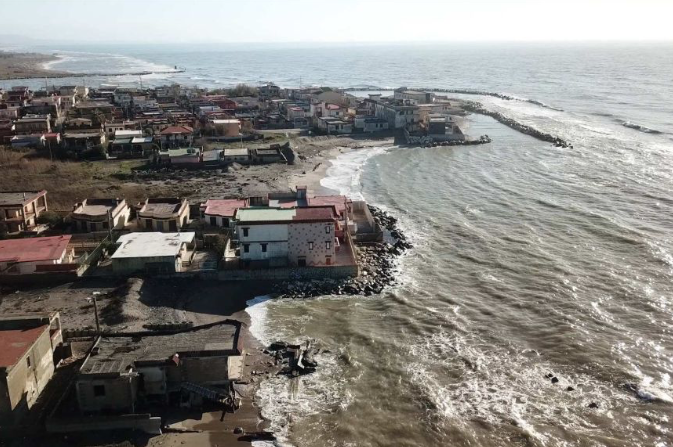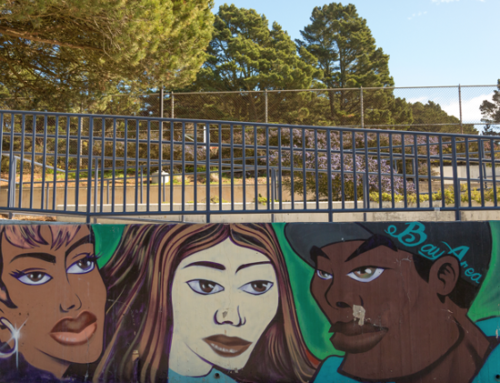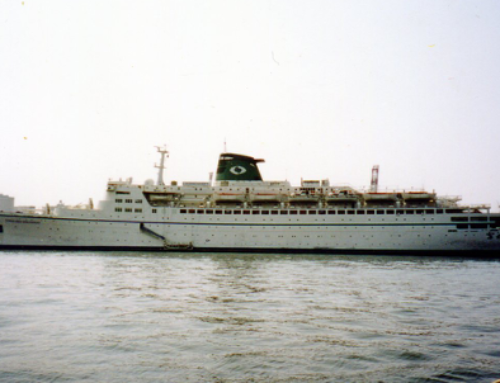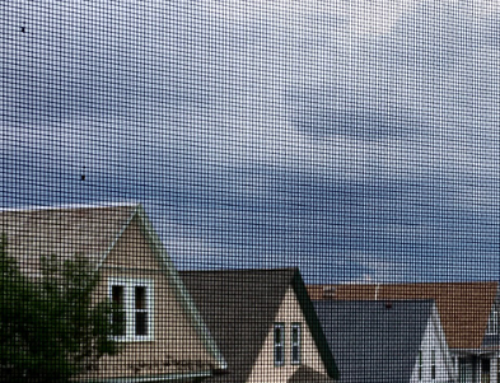Queen Miriam sits with a black axe on either side in an ornate red velvet chair gilded with gold leaf in the fading afternoon sun in the antechamber made in a rapidly dilapidating shoreline villa in the Autonomous Zone of Castel Volturno. The O Vangelo Miriam is her now official title, and the walls are surrounded with old album covers signed by all those who have ventured here to pay homage or simply to find refuge. Miriam, icon of liberated Africa, madam to the exonerated madams who extracted wealth and enforced fealty from the bevies of aspirant professionals from Enugu, Benin City, and Calabar. The latter that renowned metropolis of slaveries, crossroads of rounded up bodies scattered across its hills enticing all kinds of adventures into the dark lands, instigating all kinds of dreams of accumulation, but in the end simply a lure, a siren call to a city functioning as a trap, a massive black hole that disappeared anything that came to it. So now, this strip of coastal desolation, adventure capital land for the Casalesi Camorra now post-Covid penitenti at the altar of black lives matter, stands as the conduit for near viral transmissions of Africans across the growing shadows of Europe.
I want to speak to Miriam. I want to ask her if Stokely ever told her about those visions when he was doing time at Parchman Farm before he was even twenty about the profusion of black republics at their very own scale, neither above or below the earth’s surface, neither a matter of matrices, parallel realities, hypervisibilities or warped time. Rather simply there. Present. But undetectable. Producing no antibodies, no Sun Ra invoking “space is the place,” no Bootsy Collins inner-planetary funk. But O Vangelo is barely audible in the clamor of muezzin, organs, trances, and Amens along the Avenida Domitiata, with its scores of storefront cathedrals and prayer rooms. This is Castel Volturno’s industrial zone, its Milano of aggregations, forward and backward linkages, and synergies that deafen even the storm now visible on the horizon.
Even as the rain commences, all of the exonerated madams, the penitenti, the abdicated Lega Nord mayor, the buffalo mozzarella farmers, the Guan entrepreneurs, the Mephyte gangsters, who switched from being performance artists of bestial violence to autodidacts of pataphysics, all are gathered here in displays of exaggerated malfeasance, all pondering on how to realize transgressions of transgressions—for this is what is owed to the Queen, thought dead all of these decades, waiting in the wings, waiting on wings that surveyed the gang wars, the rehearsals of whores, the rotten mattresses that still coughed up 100 Euro a month.
It was said that Castel Volturno had died with her, and indeed there is not an intact building in sight. But what is intact anyway; what is a world that is contained and coherent in itself. A flotilla of used syringes may still advance along the floodstreams down Pescopagano, the coastal winds may still whip up the residues of the rotten fruits and vegetables that kept the broken bodies of farmworkers alive in the off season, and nights may be punctuated with the sound of ghosts boarding up broken windows and doors, but Castel Volturno was never meant to be a real city, at least this is what Miriam sang on November 9, 2008 thinking she was back on Conakry Street in Sophiatown, having thought that this Caserta town looked too much like Cape Coast and Gorée Island. And this just two months before the Strage di San Gennaro, where seven Africans were murdered by Camorra in front of the Ob Ob Fashion Shop. At the earlier concert, someone backstage had mentioned that the ships were soon arriving and all of the unsettled who over the years had arrived via Tripoli to Lampedusa to here would be carried away to plots not of their own making. The Queen’s heart gave out, was given as sacrifice to the possibilities of another disappearance.

At one with the sea, Castel Volturno. www.abc.net.au
In this antechamber is Italy in the aftermath of the third wave. Miriam is the face of the vaccine. All of the old people are gone. The Camorra runs most of the hospitals and supply chains, as that aspirant to throne, Matteo Salvini, lost his legs in a Sardines packaging plant trying to blame everything on foreigners. Offshore is replete with yachts abandoned by venture capitalists on fantasy islands where they were promptly eaten by starving immigrants from Amerika who had jumped at the opportunity to board cruise ships promising freedom from the obligations of masked survival. We can see the “local authorities” processing the “visas” of arrivals on makeshift jetties—any document will suffice, SuperEnalotto tickets, torn pieces of scripture, wedding invitations, all of which are then dutifully displayed on the walls of the town hall. Everyone must be registered; everyone must report their contacts of the past decade, which are then randomly sorted and pursued for chance encounters. Unlike most municipalities Castel Volturno recruits random citizens; after all, they are not granted allotments or voting rights but conduits to another world. Fourteen-hour quarantines are mandated in former brothels now staffed by furloughed Alitalia stewards who constantly demonstrate safety procedures and prepare everyone on how to use the exit row.
I am the part-time imam at one of the five Muslim prayer rooms that line Piazza Grimaldi, a primarily Nigerien congregation still frequently confused with the drug dealers and the jihadis. They are largely truck drivers, who bringing the loads to Libya had their vehicles confiscated, and facing no clear way to get back to Agadez or Zinder, simply took a chance on the crossing. They form small cooperatives tending to small gardens and animals at the outskirts of town, as well as take the occasional remittance from a relative paid in uranium futures by French intelligence to keep an eye on potential militants back home. They prepare the gris gris for the exodus in this mostly Pentecostal town, with its spirit possessions, abstinences, and all-night prayer sessions. Islam is more down and dirty. We don’t want to belabor things; we want to keep moving; keep what we have to say short and sweet. We don’t believe in excessive exegesis, no matter what al-Bukhari might have to say about this. A few surah sewn in leather, worn around the neck or wrist is all what we need to render ourselves viable in unexpected circumstances.
Questions of rendering have long been at the heart of “peripheral worlds”, of the constantly shifting assemblages of “we” amongst people with tentative anchorage in the familiar tropes of kinship, ethnicity, and territory. Here, the “affinal” is based, not on reciprocal exchange or common belonging, but on raiding, stealth, exorbitant displays, transgressive expenditure, simulation, “strange” alliances, and transmutations with spirits, ghosts, djinn. The figure of the collective is continuously reworked with the materials at hand. These often display “fixity” as a ruse. For my congregants, more or less Muslim, with the “more or less” itself deployed as a bargaining chip and not as a matter of proportion, a locus of intersections, aimed not to consolidate specific territories as much as to maximize reachability and spaces of autonomy. The issue is how to move quickly, work your way around, position yourself to capture opportunity, to seize and be seized (by some fortuitous games)—these are the preoccupations of figuring (things out). These are the opportunities to re-invent, but to reinvent what? The “what” itself remains to be invented.
So every Jumma prayer, on the final prostration, all of the new arrivals, anxious to fulfill their religious duty, disappear. Where did they go, and how? Why have they arrived after arduous journeys only to vanish? Yet the repurposed mafias at their banks of computers in the basement of city hall record the voluminous messages and TikTok videos of their survival now in far flung generic suburban landscapes from Lithuania to London. Rumors of an underground railroad have long circulated throughout this region, and particularly now, after the third wave.
We are now in the anteroom awaiting O Vangelo, awaiting the latest report from city hall on the multitudes now in place across every European town and city, in all of those taken for granted places—the cheap restaurants, bakeries, convenience stores, warehouses, storage spaces, and parking lots. In a time of detection, Castel Volturno not so much avoids detection, but obscures all sense of proportion. For, what if it was unclear the extent to which existent realities on the ground were at one and same time self-destructive, virtuous, frivolous, necessary, generous, and manipulative? What if it were impossible to tell exactly what is virtuous or debilitating? It breaks the possibility of detection being the method through which individual and populations are subsumed into a system of proportionality—more or less healthy, more or less immune, more or less eligible, more or less valuable. In such instances everything become experimental, heuristic, a wager on a particular disposition. Miriam raises a black axe in each hand. Everything is cut off from what is once was. Long live Africa
Cite as: Simone, AbdouMaliq. 2020. “O Vangelo, Africa.” In “Post-Covid Fantasies,” Catherine Besteman, Heath Cabot, and Barak Kalir, editors, American Ethnologist website, 27 July 2020, [https://americanethnologist.org/features/pandemic-diaries/post-covid-fantasies/o-vangelo-africa]
AbdouMaliq Simone is a Professorial Fellow at the Urban Institute, University of Sheffield.




